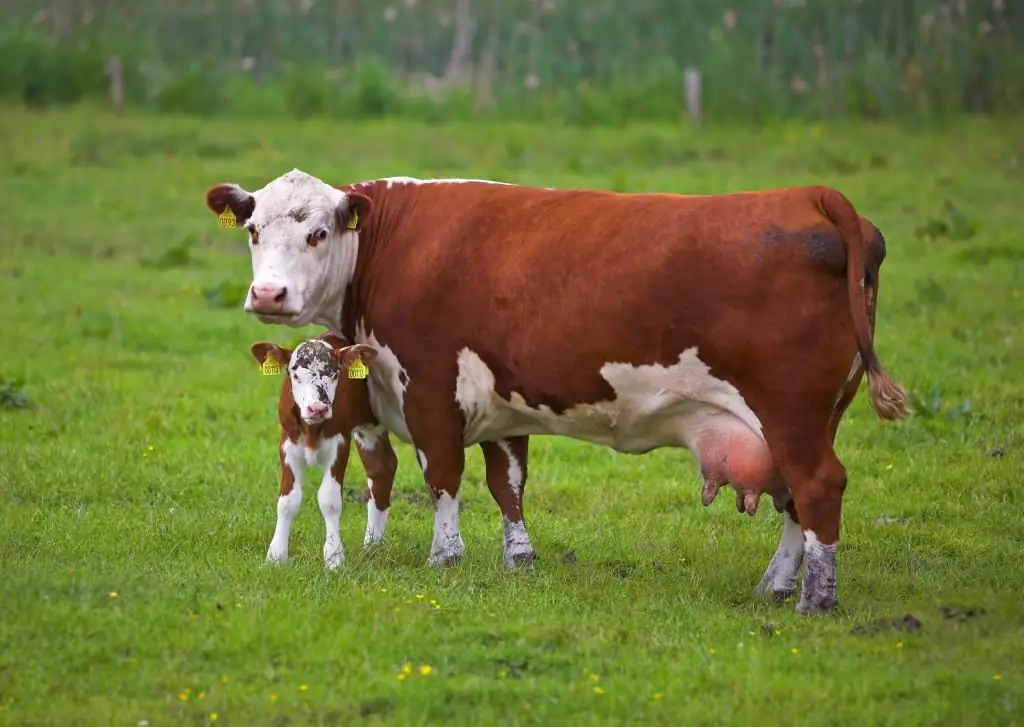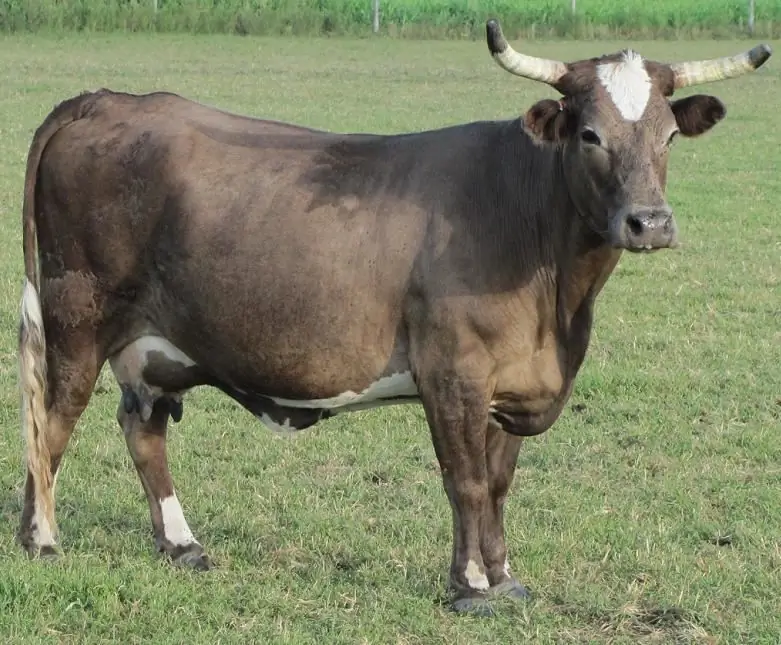2026 Author: Howard Calhoun | [email protected]. Last modified: 2025-01-24 13:10:30
Cattle fascioliasis is a disease that can bring great material damage to the farm. In an infected cow, milk yield drops, weight decreases, and reproductive function is impaired. To protect livestock, it is necessary to carry out anthelmintic treatment in a timely manner and carefully approach the choice of pastures.
History of the occurrence of the disease
In 14th century French cattle breeder Jean de Brie wrote a book about sheep breeding and wool production. In it, he mentioned a new disease that causes liver rot. Jean believed that this was due to the sheep eating poisonous herbs. After the decomposition of the liver, in his opinion, worms started in it.
In the 16th century, another book was published, written by Anthony Fitzgerbert, it was called "A New Treatise, or the Most Useful Textbook for Farmers." In it, the author described in detail the trematodes that cause fascioliasis in cattle.
Later, talented doctors began to study the disease: the Italian Gabuccini, the Frenchman Gerner, the Dutchman Gemma, the German Fromman. Their work shed light on naturefascioliasis in cattle. Later, in 1881, 2 independent fundamental works were published, written by the German Leuckart and the Englishman Thomas. They described in detail the biology of trematodes that cause fascioliasis in cattle.

Pathogen
On the territory of our country there are 2 types of fasciola - ordinary and giant. In different regions, they can be found both together and separately from each other. Liver flukes feed on blood, for this they have an oral sucker at the head end.
Pathogens are hermaphrodites, that is, they have both male and female genital organs. Fasciola reproduce by laying eggs. They have a smooth shell, at one end of which there is a cap.
The causative agents of cattle fascioliasis are biohelminths, that is, for full development they need two hosts - intermediate and final. The first of these are a variety of freshwater mollusks. More than 40 species of animals and humans can be the final host of biohelminths.
The life cycle of the causative agent of bovine fascioliasis consists of 4 stages: embryogony, parthenogony, cystogony and maritogony. The first stage is the development of the embryo and its hatching from the trematode egg. The duration of the period depends on the ambient temperature, the presence of light, the amount of oxygen. Sexually mature fasciola is capable of laying up to 3500 eggs per day, which will be removed from the body of an infected animal with feces. If the ambient temperature is below 5 degrees, then theyare dying. If higher, then the miracidium hatching period soon begins - a larval form covered with cilia.
For the onset of the next stage - parthenogony - there must be an introduction into the mollusk. In it, miracidium sheds cilia and penetrates into the internal organs. About a week later, a new stage begins - cystogonia. A sporocyst is formed, and mobile redia develop in it, having a worm-like shape. Then the process goes into its last phase - maritogony. In the bodies of redia, cercariae begin to develop. It usually takes 2 to 5 months for the parasite to develop.
What is fascioliasis
This disease is a parasitic infestation. Breeding of cattle diagnosed with fascioliasis is prohibited. This helminthiasis causes material damage to farms around the world. It affects the milk yield of cows, causes exhaustion of animals, contributes to the appearance of gynecological problems. Cattle affected by bovine fascioliasis become more susceptible to other infections.
Invasion can occur both in acute and chronic form. Fasciola most detrimentally affect the liver, as they are localized in its passages and ducts. The disease is common in all parts of the world where there is water, because it is in it that intermediate hosts, mollusks, live.

Incubation period for disease development
The duration of the asymptomatic development of the disease is often associated with the general he alth of the cow. If the immune system is strong, then the incubation period can take several months. This is dangerous because the owner canstart breeding cattle suffering from fascioliasis.
Most often, the first symptoms of the disease begin to appear after a period of 1 week to 2 months. During this time, the pathogen moves to the hepatic ducts and begins to parasitize there. The most severe disease affects sick, weakened animals with poor immunity. After the incubation period, fascioliasis usually becomes acute. If you do not provide emergency veterinary care to the animal, the disease can become chronic.

Reasons
Cattle are usually infected with fascioliasis when they are pastured to pastures infected with its pathogen. Cows can also catch helminthiasis through diseased cultivated plants, for example, fodder beets with tops or oat greens. This occurs when vegetables or cereals are irrigated with fresh water from infected water bodies. It is undesirable to give livestock to drink unboiled liquid from dubious sources. Cows must not be grazed in wetlands.
Another source of infection is sick animals. If cows are not treated for helminths before going out to pastures, then they are able to infect all surrounding livestock. Sometimes one cow suffering from fascioliasis infects a whole herd. Also, wild animals with access to pastures are a source of helminthiasis. If the owner has a suspicion of fascioliasis in his cattle, then he is obliged to provide him with emergency veterinary care.
Symptoms
When ingested, the pathogens try to get to the liver and begin to parasitize in it. There are 2 phases of developmenthelminthiasis: acute and chronic. The first stage occurs after the penetration of the pathogen inside and in the process of following it to the hepatic ducts.
Sick cattle begin to develop symptoms of fascioliasis: reduced appetite, which can later turn into a complete refusal of food, lethargy, and a decrease in milk production. A fever may begin, the temperature of the animal rises to 40 degrees and above. This causes shortness of breath, heart rhythm failure, tachycardia. The liver increases, yellowness of the mucous membranes may appear. After a few weeks, the signs of acute fascioliasis begin to subside, it passes into the chronic stage.
This phase is characterized by the exhaustion of the animal, the deterioration of its coat. A cow may have permanent recurrence of rumen stoppage. Her mucous membranes have a yellowish tint. Pregnant cows may have abortions. Animals cough. The liver is enlarged and painful on palpation. Bald spots may appear on the body. If fascioliasis is not treated at this stage, it can lead to cirrhosis of the liver.

Diagnosis
If the owner has a suspicion of helminthic infestation in his livestock, then it's time to call a veterinarian. For the diagnosis of fascioliasis, fresh manure is taken for laboratory research. To establish the diagnosis, the feces are repeatedly washed. If the animal is infected, then the eggs of the pathogen are found in it. This method is not among the most effective, the reliability of its results does not exceed 60%. Serological studies are also usedShcherbovich's method.
A veterinary specialist can also make a diagnosis based on symptoms. The season, the prevalence of the disease in the area, the nature of the course play a big role in this. Sometimes animals are exploratory slaughtered.

Patological changes
If the animal was slaughtered, then experts conduct a post-mortem examination. Usually sexually mature fascioli can be found in the ducts of the liver. They may also be present in the intra-abdominal fluid. In the chronic course of the disease, s alt is found in the bile ducts.
Fasciola themselves can be found in the tissues of dead animals. In the liver, ruptures, necrotic foci are found. Small hemorrhages are found in the intestine. Perhaps partial destruction of the liver, an increase in the gallbladder. Fluid is found in the abdominal cavity. If fascioliasis in a cow was started, then cirrhosis of the liver is diagnosed in a dead animal.
Treatment
Methods of dealing with the disease may differ depending on the age of the pathogen. This is due to the fact that different substances can affect trematodes at different periods of their lives. Most often, veterinary specialists prescribe the following drugs against bovine fascioliasis: Dertil, Alben, Fazinex, Closantel.
Most trematode medicines come in tablet form, but there are also suspensions. The drug "Closantel" is intended for subcutaneous injection. Most of the funds against helminths give a restriction on the use of milk. The drug should be selected only by a veterinarian, self-medication can lead to the death of the animal.

Prevention
To prevent the spread of fascioliasis in animals, protective measures must be taken. A good effect is given by year-round bezvygulny content. Grass for cows is mowed in sown meadows clean of fasciola or not used at all in the diet. Cultivated plants show high productivity, they are more nutritious. If it is not possible to sow meadows on your own, then you can mow grass on natural pastures, if they are not located near swamps. Harvesting hay in such places is better not to carry out. If the grass for the winter had to be mowed near the swamps, then it must be aged for at least 6 months.
Change of pastures has a good effect on reducing the incidence. Since the life cycle of fasciola takes from 70 to 100 days, this will have to be done every 2 months. It is not allowed to take out fresh manure to the fields, this creates favorable conditions for the reproduction of the parasite. Feces are stored in one place, a thermal reaction begins inside the heap and all pathogens die. After that, the rotted manure can be taken to the field.
In regions unfavorable for fascioliasis, it is imperative to carry out deworming in a timely manner. If the cows are driven out for grazing, then this event is held three times a year. To prevent the spread of fascioliasis, shellfish can be destroyed. This is done with the help of treatments with copper sulphate or promote the reproduction of waterfowl.
Is it dangerousfascioliasis for humans?
Infection of humans with fascioliasis is rare, but it does occur occasionally. Symptoms in a sick person are similar to those observed in animals. People develop a fever, a headache begins, and their he alth worsens. There may be signs of allergies, itching, urticaria. Sometimes patients have Quincke's edema. There may be pain in the right hypochondrium and epigastric region, vomiting, nausea, jaundice. The liver increases in size. Heart problems appear: tachycardia, myocarditis, chest pain. Without treatment, after a few weeks, the disease turns from an acute form into a chronic one.
In this phase, a person periodically experiences pain in the right side, the liver enlarges, jaundice may occur. If further treatment is not provided to the sick person, then the onset of cirrhosis of the liver, hepatitis, severe anemia is possible.

Conclusion
Most often, fascioliasis occurs in the southern regions, as they are more favorable for the development of its pathogens. In places that are unfavorable for the disease, it is imperative to carry out multiple preventive deworming. It is undesirable to graze cattle in lowlands or near swamps. The disease is also dangerous for humans, therefore, at the first suspicion of fascioliasis, a veterinary specialist should be called.
Recommended:
Cattle piroplasmosis: etiology, causes and signs, symptoms and treatment of cattle

Most often, outbreaks of piroplasmosis are recorded in the spring-autumn season. Cows go out to pastures where they encounter infected ticks. The disease is transmitted through the bite of a parasite and can cause a decrease in herd productivity. In some cases, the death of livestock occurs. To prevent economic losses, it is necessary to carry out preventive measures
Cattle viral diarrhea: symptoms, causes, veterinary advice on treatment and prevention

Bovine viral diarrhea mainly affects calves under the age of 5 months, and mortality in some farms is 90% of the total livestock. Several factors increase the likelihood of infection, so owners need to be very careful when caring for their livestock
Newcastle disease in poultry: causes, symptoms, diagnosis, treatment and prevention

Today, livestock farmers have faced a huge number of different ailments. Many of them can be cured with effective drugs, but there are those that are exclusively fatal. Newcastle disease is a viral disease that mainly affects birds
Hypodermatosis in cattle: causes, symptoms, diagnosis and treatment

Cattle hypodermatosis is a dangerous disease that leads to loss of animal productivity. This disease is caused by larvae of subcutaneous gadflies of two varieties. At a late stage of development, nodules form on the body of cows with hypodermatosis. This disease is contagious, so sick animals should be treated as soon as possible
Cattle trichomoniasis: causes, symptoms, diagnosis, treatment and prevention

Cattle trichomoniasis can cause huge material damage to the farm, because it affects the sexual function of the herd. Several types of pathogens lead to the disease, some of them are found in cows and pigs, others in humans. The main problem is that even after treatment of cattle trichomoniasis, some individuals will not be able to give birth, that is, they remain barren forever

